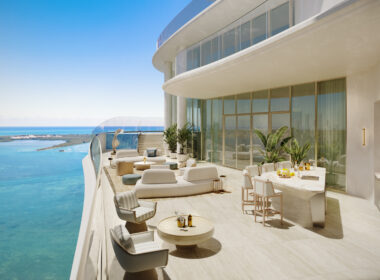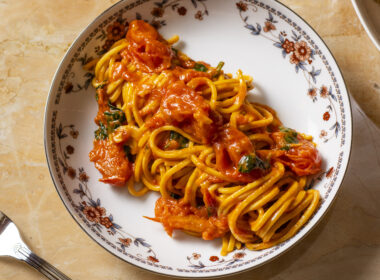Korean barbecue reaches its haute zenith at COTE
By Kylie Wang
Known as bulgogi, literally meaning “fire meat,” Korean barbecue’s roots date back 2,000 years, but didn’t gain popularity worldwide until the Korean Wave of the 1990s and early 2000s. Nowadays, eating from grills built into a table isn’t so novel, but at COTE, the experience is still one-of-a-kind.
The golden-hued dining room in the midst of Miami’s Design District is expansive, lined with comfortable black leather booths and tables inset with golden Shinpo grills, the focus of COTE’s culinary experience. The Japanese-made charcoal grills are smokeless, with a ring of exhaust ports around to keep the hot air contained and the aroma of cooking meat out of guests’ hair and clothing. Shinpo was the first to invent these back in the ‘70s, and now holds a 55 percent share of the Japanese market. COTE is one of the few U.S. restaurants that use them.



Although the restaurant uses Japanese grills, it’s still a Korean steakhouse at heart, with a well-endowed list of traditional Korean cuts and accompaniments. The illustrated menu features such headlines as “Butcher’s Feast” and “Meat, Meat & More Meat.” This is no pretension – if you’re not at COTE for the steaks, you’re not in the right place.
The Butcher’s Feast ($68 per person) is the highlight, tailored for a power lunch, and second only to the Steak Omakase Grand Tour ($225 per person) which would take a full evening and plenty of belt-loosening to appreciate. The “Feast” is plenty, featuring four four-ounce cuts of USDA Prime and American Wagyu beef, giving guests the opportunity to try four different traditional Korean steaks.
Each one is grilled at the table as per guests’ instructions. With the exception of the marinated short rib (known in Korea as galbi), each is fairly subtly seasoned with the special COTE salt blend (British Maldon salt, Himalayan pink salt, and Korean thousand-day sea salt). A special dipping sauce made from sesame, garlic, onions, ginger, jalapeños, and soy paste gives them all a slightly similar taste that is differentiated mostly by the cut of the meat itself.
The short rib is served last but must be mentioned first. The flavoring is explosive compared to the other cuts, with a sweet and savory marinade made from soy sauce, garlic, and sugar, and a slightly charred rind that elevates the caramelized flavor. The ribeye, which American steak lovers will recognize as a Delmonico and Koreans will know as kkot deung sim, is dry-aged in-house in a special room that allows for the moisture to evaporate, tenderizing the meat and heightening the flavor. The hanger steak, meanwhile, is on the leaner side, somewhat similar to a flank steak, and the classic flat iron is the restaurant’s “local favorite,” more Americanized in flavor.

With an impressively well-built menu, COTE could get by on its selection of meats alone. A coterie of accompaniments come with the Butcher’s Feast, however, including a spicy kimchi stew, one of the most traditional Korean dishes. It delivers a nice kick, with salted and fermented nappa cabbage, Korean radish, spring onions, and the all-important gochugaru, or Korean chili powder, that produces the heat and its red coloring. For the less courageous, there is also a savory (but not hot) dwen-jang stew, which is a soybean paste soup with vegetables. The table is also laden with pickled vegetables, a scallion salad, red leaf lettuce, and an egg soufflé with kelp broth. And if that is not enough, you can order from the “shareable appetizers.” We tried the COTE Ceviche, with madai (snapper), cobia (kingfish), kampachi (amberjack), and trout roe, which is distinctly Korean (vs. Peruvian) thanks to its sweet and spicy chojang vinaigrette with sesame oil, soy sauce, chili paste, and rice vinegar. Also not to be missed is the Korean “bacon,” a house-smoked crispy pork belly with pickled jalapeños and Korean mustard that is toothsome, crunchy, and salty, and much less fatty than you would expect.
But it’s the experience that shines here, offering both a conversational icebreaker and a shared meal that dives beyond the typical lunch meeting. Just walking into the restaurant alone is unique, down a blue tunnel to a visual immersion that is something more akin to an upscale club in Dubai than a restaurant in South Florida. Even for Miami’s Design District, it’s unique amongst the high-end restaurants and designer stores.











